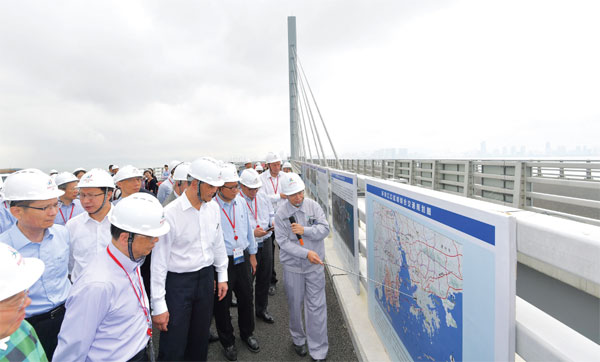HK benefits from closer ties in bay area
Updated: 2017-05-20 07:57
By Luis Liu(HK Edition)
|
|||||||
|
Chief Executive Leung Chun-ying (center) and other senior Hong Kong government officials being briefed on the progress in the construction work on the Hong Kong-Zhuhai-Macao Bridge in Zhuhai on April 21 during a tour of cities in the Guangdong-Hong Kong-Macao Greater Bay Area. Provided to China Daily |
Guangdong province now a rapidly growing economic powerhouse which will play a vital role in HK and the region's future, Luis Liu reports
Integration between Hong Kong and the mainland - especially with Guangdong province - has accelerated in the 20 years since reunification of the city with the motherland.
These closer ties will allow for even greater cooperation in future. Vital to this is the national-level blueprint of the Guangdong-Hong Kong-Macao Greater Bay Area, according to Hong Kong and Guangdong authorities.
Latest statistics show that the number of Hong Kong travel permits granted to people from Guangzhou, another mega-city in the bay area and capital of Guangdong, has increased 33 times since 1997.
The Guangzhou public security bureau handled 2.5 million permit applications last year, while in 1997 it reported only 77,833. The change reflects the special administrative region's increasingly stronger ties with Guangdong.
Authorities have also made it easier for people to apply for these permits. Now applicants can obtain them via e-channels, telephone services, mobile apps, mail and self-service machines. There are now 12 ways to have them processed without having to queue up at counters, says Cai Wei, deputy head of the Guangzhou public security bureau.
Currently, 111 self-service stations with 300 machines are accessible in Guangzhou, according to local government statistics.
One of the SAR's biggest tourist attractions is Hong Kong Disneyland - which brings many visitors from the neighboring province. Guangdong is also the largest geographical source of visitors to the park since it opened in 2005, latest figures show. Among all mainland visitors to the theme park, about a third hail from Guangdong.
As the bay area blueprint envisages greater infrastructure building, Hong Kong Disneyland aims to increase its foothold in the Guangdong market, the park announced earlier this year. Future efforts will include promotional events in Guangdong cities, transport discounts and new tour packages.
The company is considering making Guangdong a stable tourist base to maintain its competitive edge amid Greater Bay Area development.
The opposite flow of people has also been growing, which is reflected in the Hong Kong government's yearbooks. The latest statistics show that about 520,000 Hong Kong people now live in Guangdong - 7 percent of the city's population.
Common destiny
This massive people-to-people interaction will pave the way for extraordinary development opportunities. The region remains one of the most affluent parts of the country. Along with two developed economies - Hong Kong and Macao, which recorded world-leading per capita GDP of $43,000 and $69,000 respectively - economies of the other nine Guangdong cities in the Greater Bay Area are all developing impressively.
According to Guangdong province's latest statistics, the GDP growth rate of eight out of the nine cities in the Greater Bay Area has surpassed 6.9 percent - the national average.
The total volume of imports and exports between Hong Kong and Guangdong amounted to more than $200 billion - 20 percent of Guangdong's total in 2015, according to Hong Kong government statistics.
Chief Secretary for Administration Matthew Cheung Kin-chung said Hong Kong and Guangdong share a common destiny not only economically and politically - but also socially.
"Guangdong has always been the closest and most important partner of Hong Kong in terms of mainland relations," Cheung said.
The State-level Greater Bay Area blueprint was laid out when Premier Li Keqiang delivered the Government Work Report to the National People's Congress in March.
Li pledged to press ahead with development of the Greater Bay Area for higher-level cross-boundary collaboration. The establishment of the area also served as one of the key strategies in the country's Belt and Road Initiative.
The 56,500 square-kilometer bay area comprises 11 cities - the Hong Kong and Macao special administrative regions and the cities of Guangzhou, Shenzhen, Zhuhai, Foshan, Zhongshan, Dongguan, Huizhou, Jiangmen and Zhaoqing in Guangdong.
The region has a population of 67.7 million and annual GDP of $1.3 trillion (HK$10.1 trillion), according to official documents.
Business sector lawmaker, industrialist Jeffrey Lam Kin-fung said the Greater Bay Area was heading toward world-class status. The city must grab this "once-in-a-century" opportunity, Lam added. "If we miss it, there may not be a second chance," he stressed.
Lam urged Hong Kong's opposition camp to stop politicizing social issues. "Otherwise the city will be surpassed as the train of development is about to leave," he warned.
Lam said the most vital issue is to urge young people to join in with this development.
Youth exchange
In the latest meeting between the Hong Kong and Guangdong provincial governments, youth cooperation dominated discussions. The Hong Kong government decided to send 7,200 young people to Guangdong this year for people-to-people exchanges.
Cheung also announced that an internship scheme in Guangdong would be offered to 1,480 Hong Kong young people next year. This would help them acquire a more comprehensive knowledge of the mainland's job market, workplace culture and development opportunities, Cheung said.
In return, celebrating the 20th anniversary of the establishment of the Hong Kong SAR, Guangdong will organize a series of exchange events for young people from both sides. This includes soccer matches, benefit concerts, entrepreneur forums and innovation exhibitions, deputy chief of the Guangdong provincial committee of the Communist Youth League Zhang Zhihua told a recent press briefing.
Meanwhile, this year also marks the start of a number of Greater Bay Area-themed projects. These are designed to help young entrepreneurs and job seekers maximize opportunities provided by the bay area development plan.
The total number of participants from both sides would exceed 50,000, Zhang said.
Contact the writer at luisliu@chinadailyhk.com
(HK Edition 05/20/2017 page4)
